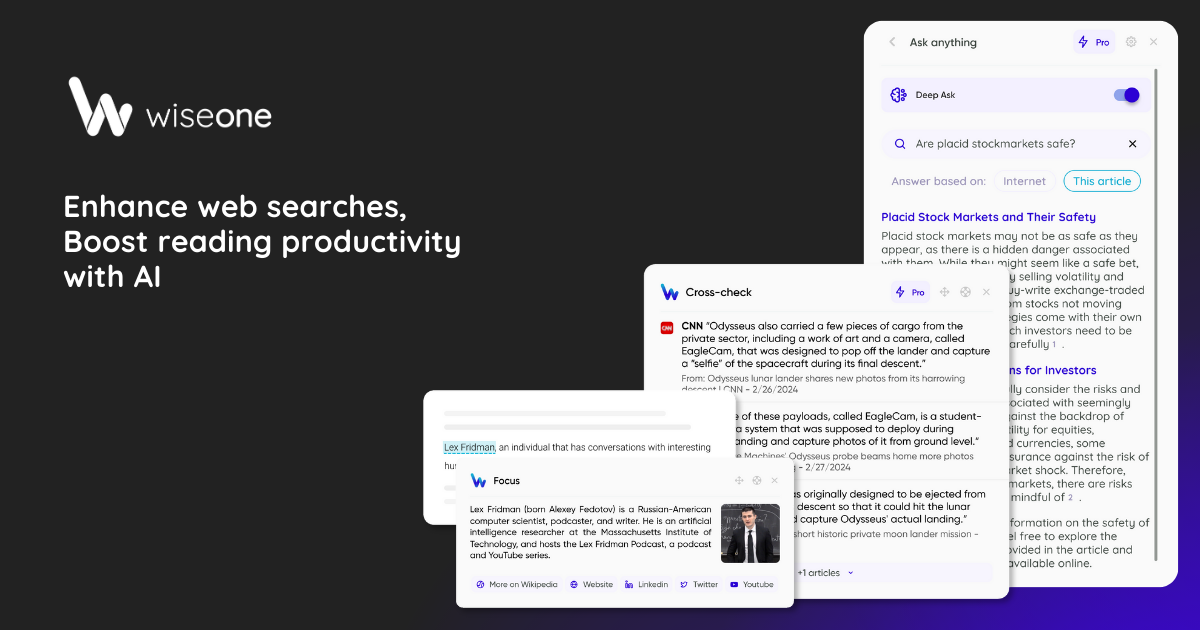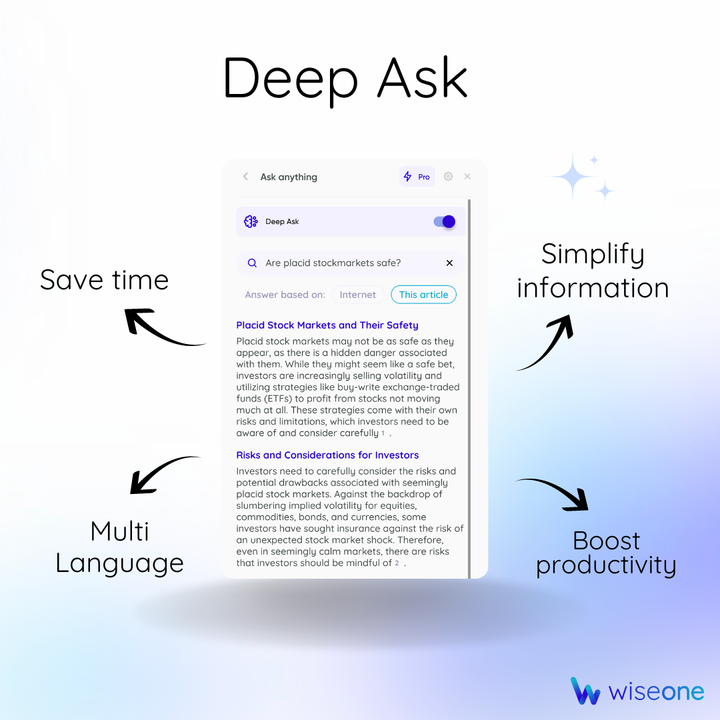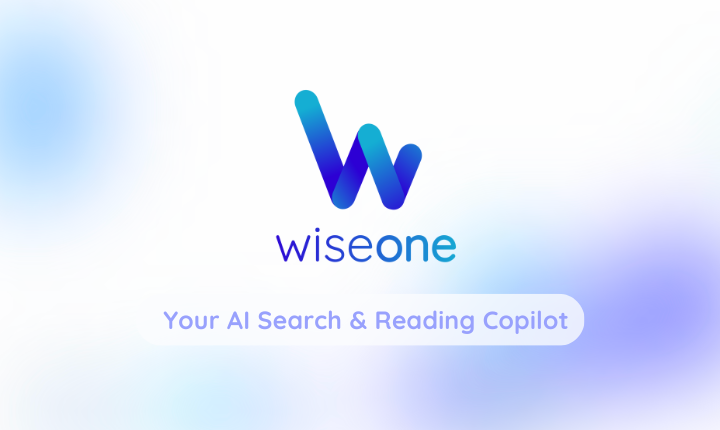Challenges at work: What are they? And how to overcome them?

In any workplace, challenges are bound to arise, whether it's due to differences in personalities, communication breakdowns, or the pressure to meet deadlines. Recognizing and effectively dealing with these challenges is essential to maintaining a productive and harmonious work environment.
Let's explore some common workplace hurdles and explore strategies to overcome them:
1- Information overload
Information overload in the workplace often originates from overwhelming online information.
This leads to inefficiencies in searching for relevant content and the subsequent consumption of lengthy articles or documents. This challenge can result in wasted time and decreased productivity as employees need help to sift through vast information to find what they need.
How to overcome information overload
Wiseone offers a solution to information overload with its time-saving features. By eliminating the constant need to search and read through various web pages, PDFs, and lengthy articles, Wiseone saves professionals valuable time that would otherwise be spent on information retrieval.

Additionally, the AI tool enhances productivity by providing an efficient overview and essential information about any web content to complete more work with less time and effort.
The AI-powered tool enables users to focus on different tasks and projects by delivering the most pertinent information, thereby maximizing productivity and efficiency in the workplace.
2- Poor Communication
Clear, effective communication is the lifeblood of any successful organization. Yet, miscommunication or the lack thereof can cause issues with projects and relationships in the busy daily routine. Fostering an environment where open dialogue is encouraged and celebrated is essential.
How to overcome poor communication in the workplace
Establish regular team meetings to promote transparency and alignment. Encourage active listening and provide channels for feedback. Embrace technology like collaboration tools to streamline communication and keep everyone on the same page.
3- Conflict Among Team Members
Divergent personalities, conflicting priorities, and differing perspectives can ignite disagreement within coworkers, threatening to derail progress and generate resentment.
Conflict among team members can arise in various forms. One common type is task-based conflicts, when team members depend on each other to complete a task or project. Suppose one team member fails to fulfill their responsibilities. In that case, it can impact the rest of the team. Another cause of conflict is change resistance, where team members or the team are hesitant or unwilling to adapt to new circumstances. This resistance can lead to disagreements and tensions within the team.
How to Overcome Conflict Among Team Members
Address conflicts head-on, creating a safe space for constructive dialogue and resolution. Implement team-building exercises and workshops to foster empathy and understanding among colleagues. Lead by example, demonstrating respectful communication and conflict resolution skills.
4- Lack of Motivation
Lack of motivation in the workplace can be a significant issue that affects employees' performance and overall job satisfaction. One common reason is a value mismatch. When an individual's values and beliefs do not align with the organization's values or goals, it can lead to a lack of motivation.
Another factor is a need for more self-efficacy. Professionals may become demotivated if they do not believe in their abilities to perform tasks successfully or feel overwhelmed by their work challenges.
Disruptive emotions can also contribute to a lack of motivation in the workplace. Negative emotions such as stress, anxiety, or frustration can hinder engagement and enthusiasm for work, leading to decreased motivation.
How to overcome the lack of motivation
Recognize and celebrate achievements, no matter how small, to fuel a culture of appreciation and recognition. Provide opportunities for skill development and career growth to reignite employees' passion for their work. Empower individuals by delegating responsibilities and granting autonomy in decision-making.
5- Micromanagement
Micromanagement is a management style characterized by a manager closely observing and controlling their employees' work. Though often well-intentioned, micromanagement can suffocate employees' creativity, erode trust, and impact their growth.
It's essential to have a balance between oversight and autonomy is crucial to gain a culture of empowerment.
How to overcome micromanagement in the workplace
Trust your team members to deliver results by providing clear expectations and guidelines. Delegate tasks based on individuals' strengths and competencies, allowing them the freedom to excel. Offer support and guidance when needed, but resist the urge to micromanage every detail.
6- Work-Life Balance Issues
Work-life balance issues are prevalent in modern workplaces, with various factors contributing to this challenge. Poor management, long working hours, and blurred boundaries between work and personal life can lead to little to no work-life balance. Around 26% of employees work outside business hours. This intrusion can have detrimental effects on mental and physical health as individuals struggle to disconnect from work-related stressors.
How to overcome work-life balance issues
Champion work-life balance by promoting flexible schedules, remote work options, and wellness initiatives. Encourage employees to unplug and recharge outside of office hours. Lead by example by respecting boundaries and prioritizing self-care.
7- Resistance to Change
Change is inevitable, yet it's often met with resistance from those comfortable with the status quo. Individual resistance occurs when employees resist change based on their unique perceptions, personalities, and needs. Factors such as job security, habit, and economic considerations significantly influence individual resistance to change.
On the other hand, organizational resistance refers to an organization's tendency to resist change and hold on to the status quo. Companies that experience this type of resistance may find it challenging to implement changes successfully and adapt to new circumstances.
Resistance to organizational change can also stem from a lack of information about the proposed changes, including details about change procedures, the urgency of the changes, and the benefits resulting from the changes.
How to overcome the resistance to change
Transparently communicate the reasons behind the changes, address concerns, and solicit stakeholder feedback. Promote a culture of agility and innovation where experimentation and adaptation are valued. Provide training and support to equip employees with the skills to navigate transitions smoothly.
8- Lack of Recognition
Employee recognition is crucial in the workplace. One of the top reasons employees leave their jobs is a need for recognition.
In today's competitive and stressful work environment, employees don't just work for a paycheck; they also need to feel appreciated and acknowledged for their contributions. Recognition not only boosts individual employee engagement but also increases productivity and loyalty to the company, ultimately leading to higher retention rates.
How to overcome the lack of Recognition
Implement formal recognition programs that acknowledge individual and team achievements. Encourage peer-to-peer recognition to foster a sense of camaraderie and appreciation. Regularly express gratitude and recognize employees' efforts at all levels of the organization.
9- Diversity and Inclusion Issues
Diversity in the workplace refers to the variety of differences among people in an organization. These differences include race, age, gender, sexual orientation, skills, and personality traits. Employees come from various cultural, academic, and professional backgrounds in a diverse workplace, creating a rich tapestry of experiences and perspectives.
Inclusion is the practice of ensuring that all employees feel welcomed, respected, and valued. It involves creating an environment where everyone can fully participate and contribute to the organization's success. Inclusion goes beyond having diverse representation; it fosters a sense of belonging and acceptance for every employee.
How to overcome diversity and inclusion issues
Foster a culture of inclusivity by promoting diversity in hiring practices and decision-making processes. Provide diversity training to raise awareness and cultivate empathy among employees. Create open dialogue and education opportunities around diversity-related issues, ensuring everyone feels valued and respected.
10- Unclear Goals and Expectations
Without a clear sense of direction, employees may feel adrift and unsure what is expected of them or how their work contributes to broader organizational goals.
Unclear goals can lead to confusion, misunderstandings, and inefficiencies within a team or company. When goals and expectations are clear, employees may need help understanding their expectations, resulting in increased productivity and missed deadlines.
How to overcome unclear goals and expectations
Communicate goals and expectations clearly and consistently, ensuring alignment across teams and departments. Set SMART goals that are specific, measurable, achievable, relevant, and time-bound. Provide regular feedback and performance evaluations to keep employees on track and motivated.
FAQ
How to overcome information overload
Wiseone offers a solution to information overload with its time-saving abilities. By eliminating the constant need to search and read through various web pages, PDFs, and lengthy articles, Wiseone saves professionals valuable time that would otherwise be spent on information retrieval.
How to overcome poor communication
Establish regular team meetings to promote transparency and alignment. Encourage active listening and provide channels for feedback. Embrace technology like collaboration tools to streamline communication and keep everyone on the same page.
How to overcome conflict among team members
Address conflicts head-on, creating a safe space for constructive dialogue and resolution. Implement team-building exercises and workshops to foster empathy and understanding among colleagues. Lead by example, demonstrating respectful communication and conflict resolution skills.
How to overcome the lack of motivation
Recognize and celebrate achievements, no matter how small, to fuel a culture of appreciation and recognition. Provide opportunities for skill development and career growth to reignite employees' passion for their work. Empower individuals by delegating responsibilities and granting autonomy in decision-making.
How to overcome micromanagement in the workplace
Trust your team members to deliver results by providing clear expectations and guidelines. Delegate tasks based on individuals' strengths and competencies, allowing them the freedom to excel. Offer support and guidance when needed, but resist the urge to micromanage every detail.
How to overcome work-life balance issues
Champion work-life balance by promoting flexible schedules, remote work options, and wellness initiatives. Encourage employees to unplug and recharge outside of office hours. Lead by example by respecting boundaries and prioritizing self-care.
How to overcome the resistance to change
Transparently communicate the reasons behind the changes, address concerns, and solicit stakeholder feedback. Promote a culture of agility and innovation where experimentation and adaptation are valued. Provide training and support to equip employees with the skills to navigate transitions smoothly.
How to overcome the lack of Recognition
Implement formal recognition programs that acknowledge individual and team achievements. Encourage peer-to-peer recognition to foster a sense of camaraderie and appreciation. Regularly express gratitude and recognize employees' efforts at all levels of the organization.
How to overcome diversity and inclusion issues
Foster a culture of inclusivity by promoting diversity in hiring practices and decision-making processes. Provide diversity training to raise awareness and cultivate empathy among employees. Create open dialogue and education opportunities around diversity-related issues, ensuring everyone feels valued and respected.
How to overcome unclear goals and expectations
Communicate goals and expectations clearly and consistently, ensuring alignment across teams and departments. Set SMART goals that are specific, measurable, achievable, relevant, and time-bound. Provide regular feedback and performance evaluations to keep employees on track and motivated.
Enhance your web search,
Boost your reading productivity with Wiseone



